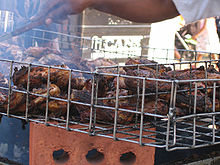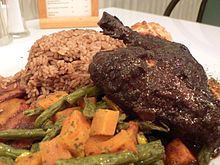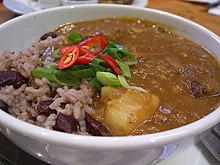jamaican cuisine
|
|
This article needs additional citations for verification. (February 2011) |

Jerk chicken being cooked. Jerk-style cooking is a distinctly Jamaican style of barbecuing meats, is now one of the most popular Jamaican foods worldwide.
Jamaican cuisine includes a mixture of cooking techniques, flavors, spices and influences from the indigenous people on the island, and the Spanish, British, Africans, Indian and Chinese who have inhabited the island. It is also influenced by the crops introduced into the island from tropical Southeast Asia. Jamaican cuisine includes various dishes from the different cultures brought to the island with the arrival of people from elsewhere. Other dishes are novel or a fusion of techniques and traditions. In addition to ingredients that are native to Jamaica, many foods have been introduced and are now grown locally. A wide variety of seafood, tropical fruits and meats are available.
Some Jamaican cuisine dishes are variations on the cuisines and cooking styles brought to the island from elsewhere. These are often modified to incorporate local produce. Others are novel and have developed locally. Popular Jamaican dishes include curry goat, fried dumplings, ackee and salt fish (cod) (which is the national dish of Jamaica), fried plantain, “jerk“, steamed cabbage and “rice and peas” (pigeon peas or kidney beans). Jamaican Cuisine has been adapted by African, Indian, British, French, Spanish, Chinese influences. Jamaican patties and various pastries and breads are also popular as well as fruit beverages and Jamaican rum.
Jamaican cuisine has spread with emigrations, especially during the 20th century, from the island to other nations as Jamaicans have sought economic opportunities in other areas.
Contents |
[edit] History

Women selling desserts in Kingston, Jamaica, c. 1899
[edit] Cuisine of the Tainos
Christopher Columbus visited Jamaica multiple times towards the end of the 15th century and the beginning of the 16th century, once even shipwrecked on the north coast for twelve months (1503–1504).
[1] Hale, Edward Everett, 1822-1909. The Life of Christopher Columbus: from his own letters and journals and other documents of his time. “CHAPTER XII, Refuge at Jamaica.” 1891. Electronic Text Center, University of Virginia Library.
During these visits he described a way the Arawaks (the indigenous inhabitants of Jamaica) preserved meat by adding peppers, allspice and sea salt to make what is now known as Jamaican jerk spice[citation needed].
[edit] Development of the cuisine
The Spanish, the first European arrivals to the island contributed dishes such as the vinegary concoction escovitched fish (Spanish escabeche) contributed by the Spanish Jews. Later, Cantonese/Hakka influences developed the Jamaican patty, an empanada styled turnover filled with spiced meat. African cuisine developed on the island as a result of waves of slavery introduced by the European powers. More Chinese and East Indian influences can also be found in Jamaican cuisine, as a result of indentured labourers who replaced slaves after emancipation brought their own culinary talents (especially curry, which Jamaican chefs sometimes use to season goat meat for special occasions).
African, Indian, American, Chinese and British cuisines are not new to the island. Through many years of British colonialism the cuisine developed many habits of cooking particular to a trading colony. The natives of Jamaica drink the most tea per capita in the Caribbean to this day as a result[citation needed].
[edit] Jamaican Cuisine and the Rastafarians
Jamaican Food Facts The Jamaican cuisine is quite diverse and mention must be made of the Rastafarian influence. Rastafarians have a vegetarian approach to preparing food, cooking, and eating, and have introduced a host of unique vegetarian dishes to the Jamaican cuisine. They do not eat pork, and the strict ones do not eat meat, including poultry and fish. There are even some who believe in cooking with little or no salt and cooking in an ‘Ital‘ way.
[edit] Popular ingredients

Jamaican patties and Red Stripe beer
- Ackee
- Allspice (locally known as “pimento”)
- Avocado (locally known as “pear”)
- Black pepper
- Breadfruit
- Callaloo
- Yuca (locally known as “Cassava”)
- Chayote (locally known as “chocho”)
- Coconut
- Coconut milk
- Escallion
- Green Banana
- Ginger
- Pigeon peas (locally known as “gungo peas”)
- Plantain
- Scotch bonnet (pepper)
- Taro (locally known as “dasheen” or “coco”)
- Jerk spice
- Yam (vegetable)
- Garlic
- Dried and salted cod (locally known as “salt fish”)
- Salt beef
- Thyme
- Oxtail
- Cow feet
- Pig tail and ears
- Guava
- Passion fruit
- Soursop
- Sugar cane
- Ketchup
- Onion
- Browning Sauce
- Boniato (locally known as “sweet potato”)
- Calabaza (locally known as “pumpkin”)
- Anatto
- Gungo pea
- Kidney bean
- Roselle (plant) (locally known as “sorrel”)
- Tamarind
- Acerola (locally known as “cherry”)
- Lima bean
- Chondrus crispus
- Tahitian apple (locally known as “June plum”)
- Jackfruit
- Pineapple
- Malay apple (locally known as “apple” or “Otaheite apple”)
- banana
- Vinegar
[edit] Popular dishes

A Jamaican patty wrapped in coco bread
A Jamaican breakfast includes ackee and saltfish, seasoned callaloo, boiled green bananas, and fried dumplings.[1]
[edit] Main courses
- Ackee and saltfish
- Jerk chicken – grilled Jerk-spiced chicken/pork
- Curry goat/mutton
- Jamaican patties (beef, chicken, vegetarian, cheese)
- Brown Stew Chicken
- Escoveitch fish (similar to Spanish escabeche)
- Oxtail with broad beans
- Corned Beef and cabbage
- Saltfish with cabbage or callaloo
- Steamed fish
- Jamaican spiced bun
[edit] Soups
- Mannish Water (Head and “man meat” of Goat soup) – said to be an aphrodisiac. Traditionally eaten at New Year’s Eve[citation needed]
- Coconut Rundown – spicy mackerel and coconut stew
- Fish tea
[edit] Side dishes
- Rice and peas – rice stewed with beans and coconut milk. Otherwise known as “Jamaican Coat of Arms”.
- Festival – Jamaican-style sweet fried maize dumpling
- Pilau – a dish containing rice, chicken, pork, shellfish, and vegetables, similar to Paella while the name is derived from the Indian pulav
- Red Peas Soup
- Stewed Peas
- Callaloo
- Cabbage
- Pepperpot Soup
- Okra (also Okra and saltfish stew)
- Pigfoot
- Cowfoot
- Solomon gundy
- Spinners – dumplings shaped by “spinning” them in the hands.[2]
[edit] Breads and pastries
[edit] Beverages
- Carrot juice with spices such as nutmeg and vanilla
- Guinness punch with spices such as nutmeg and vanilla
- Ginger beer
- Irish Moss (also called sea moss) a milkshake-like beverage.[3] It is made from Gracilaria spp, rather than Chondrus crispus.[citation needed]
- Limeade
- Mango juice
- Peanut punch
- Sorrel drink
- Tamarind drink
- Bush tea
- Tamarind Fizz
- Cucumber juice
- Otaheiti Apple Juice
- Sour Sop juice
- Hot Chocolate
- Sky Juice
- Suck-Suck
- Ting soda
[edit] Desserts and Sweets

Gizzada pastry with coconut, sugar, nutmeg and vanilla
Mango and soursop ice cream are two popular desserts. Jamaican ice cream is traditionally made with coconut milk, and come in popular flavours like [grapenut]] and rum and raisin.
Other popular desserts include potato pudding, gizzada (a small tart shell with sweet spiced coconut filling), grater cake, toto (dessert) (a small coconut cake), banana fritters, coconut drops, plantain tart.
Duckunoo or blue drawers is a dish made by combining a starch (usually cornmeal or cassava) with coconut milk, then wrapped and tied in banana leaf before boiling.
Asham is parched corn that is ground and combined with brown sugar.
Bustamante Backbone, named after the first Prime Minister Alexander Bustamante, is a candy.
[edit] Jamaican food abroad
Jamaican cuisine is available throughout North America, the United Kingdom, and other places with a sizeable Jamaican population. In the United States, a large number of restaurants are located throughout New York’s boroughs, Atlanta, Fort Lauderdale, Washington DC, Philadelphia, and other metropolitan areas. In Canada, Jamaican restaurants can be found in the Toronto metropolitan area, as well as Vancouver, Montreal, and Ottawa. Jamaican dishes are also featured on the menus of Bahama Breeze, a US-based restaurant chain owned by Darden Restaurants.
Golden Krust Caribbean Bakery & Grill is a chain of about 120 franchised restaurants found throughout the U.S. These restaurants sell Jamaican patties, buns, breads, and dinner and lunch dishes. They also supply food to several institutions in New York.
[edit] References

Ackee fruit
- ^ Deborah S. Hartz Authentic Jamaican breakfast Aug 1, 1991 Ocala Star-Banner page 44
- ^ Dictionary of Jamaican English By Frederic Gomes Cassidy, Robert Brock Le Page page 420
- ^ http://pqasb.pqarchiver.com/newsday/access/104297272.html?dids=104297272:104297272&FMT=ABS&FMTS=ABS:FT&type=current&date=Feb+04%2C+1987&author=SYLVIA+CARTER&pub=Newsday+(Combined+editions)&desc=A+TASTE+OF+THE+ISLANDS&pqatl=google
[edit] External links
| Wikimedia Commons has media related to: Cuisine of Jamaica |
- Jamaican Food Facts and Recipes
- Jamaican Food and Recipes
- Jamaica Recipes (includes description of Jamaican Cuisine)
|
||||||||||||||||||||||||||||||||||||||
|
||||||||
This article uses material from the Wikipedia article jamaican cuisine, which is released under the Creative Commons Attribution-Share-Alike License 3.0.








